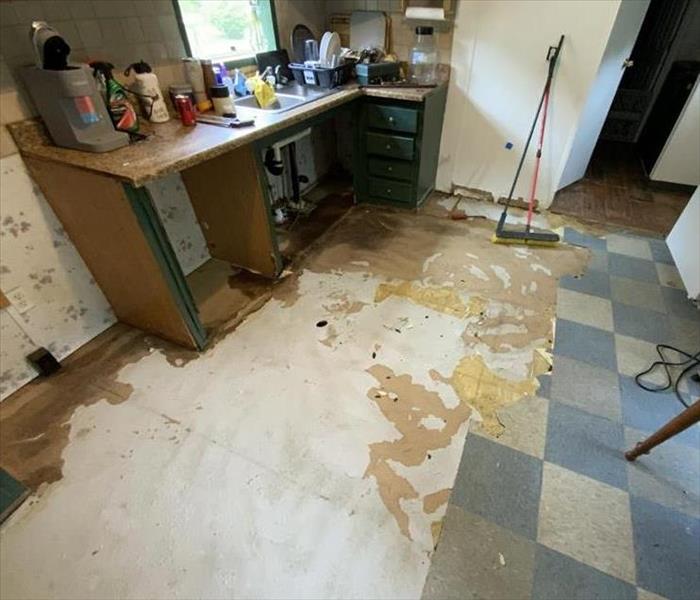When Water Damage Requires Floor Replacement: How SERVPRO Handles the Process
8/20/2024 (Permalink)
 At SERVPRO®, we’re experts in managing water damage and ensuring a seamless restoration process, including when it comes to handling floor damage.
At SERVPRO®, we’re experts in managing water damage and ensuring a seamless restoration process, including when it comes to handling floor damage.
Water damage can be devastating, and sometimes the extent of the damage is so severe that it necessitates ripping up and replacing the flooring. Whether it’s due to a burst pipe, severe flooding, or a leaky roof, the process of removing and replacing damaged floors can be complex and requires a careful approach. At SERVPRO®, we’re experts in managing water damage and ensuring a seamless restoration process, including when it comes to handling floor damage.
1. Assessing the Damage
The first step in addressing water damage that affects the flooring is a thorough assessment:
- Inspection: Our team conducts a detailed inspection to determine the extent of the water damage. We assess the condition of the flooring, subfloor, and underlying structures to understand the full impact.
- Moisture Detection: Using advanced moisture meters and thermal imaging cameras, we identify any hidden moisture that may not be immediately visible but could affect the structural integrity.
2. Containing and Removing Water
Before any flooring can be removed, we need to ensure that the area is dry and safe:
- Water Extraction: We use powerful pumps and vacuums to remove standing water from the affected area. This step is crucial to prevent further damage and mold growth.
- Drying: Industrial-grade air movers and dehumidifiers are deployed to thoroughly dry the area. We monitor the drying process to ensure that all moisture is removed before proceeding.
3. Removing Damaged Flooring
Once the area is dry, we carefully remove the damaged flooring:
- Flooring Removal: Our team removes the affected flooring materials, which could include carpet, hardwood, laminate, or tile. We do this with precision to avoid causing additional damage to the subfloor.
- Subfloor Inspection: After removing the flooring, we inspect the subfloor for any signs of water damage or rot. It’s important to address any issues with the subfloor to ensure a solid foundation for the new flooring.
4. Addressing Underlying Issues
Before installing new flooring, it’s essential to address any underlying issues:
- Repairs: If the subfloor or underlying structures have been damaged, we perform the necessary repairs. This might involve replacing rotted wood or addressing structural concerns.
- Mold Remediation: If there’s any sign of mold, we handle mold remediation to ensure that your home is safe and healthy. This involves removing mold, treating affected areas, and preventing future growth.
5. Installing New Flooring
With the area prepared, we move on to installing new flooring:
- Choosing Materials: We work with you to choose the best flooring materials for your needs and preferences. Whether you’re replacing carpet with hardwood or opting for new tile, we ensure that the materials are suitable for the space.
- Professional Installation: Our experienced team handles the installation of the new flooring with care. We ensure that the installation is done correctly and meets industry standards for durability and appearance.
6. Final Touches and Inspection
Once the new flooring is installed, we perform a final inspection:
- Quality Check: We review the work to ensure that everything meets our high standards and that the new flooring is installed correctly.
- Cleanup: We handle any cleanup related to the restoration process, leaving your home in pristine condition.
7. Preventing Future Damage
To help prevent future water damage, we offer advice and solutions:
- Leak Detection: We provide recommendations for maintaining plumbing systems and detecting leaks early.
- Waterproofing: For areas prone to water damage, we can suggest waterproofing solutions to protect your home.
Conclusion
Dealing with water damage that results in ripping up and replacing the flooring requires a meticulous approach to ensure that the restoration is thorough and effective. At SERVPRO, we handle every step of the process with expertise, from initial assessment to the final installation of new flooring. Our goal is to restore your home to its pre-damage condition, ensuring that it is safe, functional, and beautiful. If you’re facing water damage issues that impact your flooring, contact SERVPRO today to get expert help and peace of mind throughout the restoration process.

 24/7 Emergency Service
24/7 Emergency Service